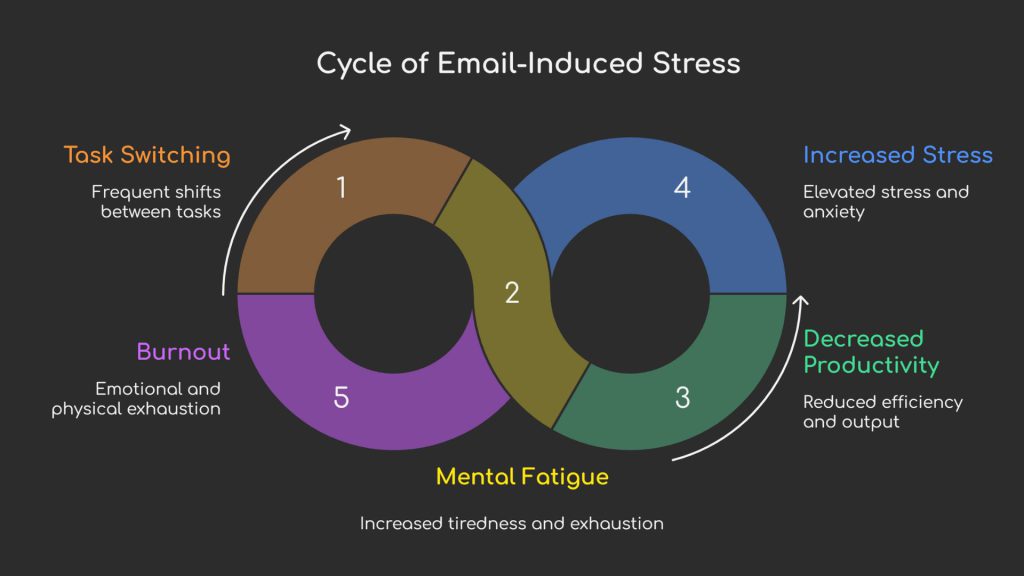In today’s fast-paced work environment, email has become both a vital communication tool and a significant source of stress. Whether it’s the constant flow of incoming messages or the overwhelming pressure to be available 24/7, email overload is contributing to burnout culture in many workplaces. But what role do Out-of-Office (OOO) messages play in all of this, and how can email verification help reduce stress and improve productivity?
In this blog, we will explore how email habits and OOO messages reveal the deeper issue of burnout culture, and what can be done to reduce email-induced stress.
The Rise of Email Overload

Email was designed to help us communicate more efficiently. However, as its usage has increased, it has also become a significant source of workplace stress. In fact, studies show that the average employee spends about 20 hours per week managing their email inbox. That’s almost half a workweek!
This constant influx of messages, many of which are urgent, can lead to burnout. Employees find themselves reacting to emails rather than proactively completing tasks. In a survey conducted by Asana, 42% of workers reported feeling overwhelmed by the volume of emails they receive every day.
How Does Email Overload Lead to Burnout?
When email becomes a constant interruption, it creates a cycle of stress. Constantly switching between tasks (like answering emails and completing work) increases mental fatigue. As you move from one task to another, your brain has to reset each time, which makes you more tired and less productive.
This constant context-switching results in decreased productivity, and your ability to focus on essential tasks gets compromised. Over time, this increases feelings of stress and burnout.
The Psychological Effects of Email Overload
Email overload doesn’t just affect your productivity; it can have a profound impact on your mental health. The constant flood of messages can cause anxiety and email fatigue. You might feel like you’re always on edge, waiting for the following important email. This creates what we call email anxiety; a constant sense of urgency.
When employees feel pressured to keep up with their inboxes, they often experience decision fatigue. Every time you check your inbox, you are forced to make decisions: Should you reply now? Should you ignore this message? Should you flag it for later? These repeated decisions, no matter how small, add up to an emotional and mental toll that significantly impacts your ability to focus and be productive.
Email Fatigue and Decision Fatigue
Every time you check your email, you are making decisions. Whether to respond now, mark it for later, or ignore it, these small decisions add up over time, leading to decision fatigue. When you’re overwhelmed by the number of decisions you have to make about your emails, it becomes harder to focus on the critical tasks in your workday.
Out-of-Office (OOO) Messages: A Tool for Managing Work-Life Boundaries
Out-of-Office (OOO) messages are no longer just a polite way to inform people that you’re away. They have become an essential tool for managing boundaries and reducing email-induced stress. In today’s world of always-on culture, an OOO message is a powerful signal to colleagues and clients that you are not available for immediate responses.
How Do OOO Messages Help Prevent Burnout?

By setting clear expectations with an OOO message, you’re signalling that your time is valuable and that you need rest to avoid burnout. When you return from a break and are met with a cluttered inbox, OOO messages allow you to manage those emails without feeling overwhelmed. They create a clear distinction between work and personal time, allowing you to disconnect and recharge without feeling the constant pressure to respond.
Out-of-office messages have evolved significantly. While they used to be simple, polite notifications of absence, now many professionals are using them as a proactive way to protect their time and set clear boundaries.
The Cycle of Email-Induced Burnout
Email overload can create a vicious cycle. It starts with a constant influx of messages, leading to stress. As a result, employees may begin avoiding emails, only to feel guilty about the backlog that continues to grow. This avoidance behaviour leads to even more stress and exhaustion.
This cycle becomes a self-perpetuating problem. The longer you avoid dealing with your email, the more anxiety builds up. When you eventually face the overwhelming number of unread messages, the stress is amplified, leading to emotional burnout.
Common Question: How Can I Reduce Email Stress at Work?
It’s important to set boundaries and take control of your inbox. Simple strategies like setting specific times for checking emails, turning off notifications, and using filters can help you regain control. This reduces the feeling of being constantly “on call.”
- Set Time Blocks for Email: Instead of constantly checking your email, set specific times in the day to manage your inbox. This can help you stay focused on the tasks at hand without being interrupted.
- Use Filters and Folders: Organise your inbox by categorising emails into folders. This makes it easier to prioritise essential emails and focus on what matters most.
- Turn Off Notifications: Disabling notifications outside of work hours ensures you’re not distracted by emails when you’re not working, helping you maintain a healthier work-life balance.
How Email Verification Helps Prevent Burnout
Email verification is often overlooked when talking about email management, but it plays a crucial role in reducing inbox overload. By ensuring that only valid, verified email addresses are being used, you can drastically cut down on the number of spam and irrelevant emails you receive.
Reducing Spam and Inbox Clutter
The average worker spends 3-4 hours a week just dealing with junk emails. By using email verification tools, you ensure that you only receive emails from valid addresses, helping you avoid unnecessary clutter and focus on essential tasks. This reduces stress and mental fatigue.
Improving Communication Efficiency
When you use email verification tool, you ensure that your messages are reaching the right people. This reduces the likelihood of bouncing emails and improves communication efficiency, allowing workers to focus on tasks that matter rather than chasing down missing emails.
Email verification also helps prevent miscommunications that can cause additional stress in the workplace, as workers don’t have to worry about emails being lost or incorrectly sent to invalid addresses.

Tips for Managing Email Stress and Preventing Burnout
Managing email stress doesn’t require drastic changes. There are simple steps you can take to take back control of your inbox and prevent burnout:
- Set Specific Email-Checking Times: Schedule times throughout the day to check and respond to emails rather than checking continuously.
- Use Email Filters: Organise your inbox by using filters and labels. This helps you prioritise important emails and reduces decision fatigue.
- Turn Off Email Notifications: Disable notifications outside of working hours so you can focus on other tasks without interruption.
- Unsubscribe from Unnecessary Emails: Clean up your inbox by unsubscribing from newsletters and promotional emails that no longer serve you.
The Role of Email and Out-of-Office (OOO) Messages in Remote Work

With remote work on the rise, managing email overload has become even more challenging. Remote workers often face additional stress from time zone differences and the blurred line between work and personal life. OOO messages become even more critical in these settings to protect time off and prevent burnout.
In remote work environments, it is essential to set boundaries, not just with colleagues but with yourself. Without a clear boundary between work hours and personal time, remote workers may have to be constantly available for emails. This contributes to a sense of being always on, which can easily lead to burnout.
Conclusion
Email overload is one of the most significant contributors to burnout in today’s workplace. With the rise of always-on culture, it’s easy to feel like you’re drowning in a sea of emails. However, by implementing simple strategies like using OOO messages, setting email boundaries, and leveraging email verification, you can regain control of your inbox and reduce the stress that leads to burnout.
If you’re struggling with email overload, start small; implement some of these strategies today and see how they can improve your productivity and mental well-being. By taking proactive steps, you can create a healthier work-life balance and avoid the burnout that too often accompanies email stress.
Bonus: Expert Tips and Case Studies
Incorporating email management tools has helped many businesses reduce email-induced burnout. For example, Company X saw a 30% decrease in email-related stress after implementing a policy of no emails after 6 PM. This approach has helped their employees feel more empowered and balanced.
Additional Resources
Tools for Managing Email Overload: Look into tools like SaneBox and Unroll.me, Boomerang, am responsible for email management and scheduling.
FAQs About Email Overload, Burnout, and Email Management
How does email overload lead to burnout?
Email overload contributes to burnout because it traps employees in a paradigm where constant tasks and requests bombard them. The continuous pressure of incoming email leads to more stress, less focus, and more emotional exhaustion, and very low productivity can completely destroy employees’ wellbeing.
What psychological impacts does email overload produce?
Essentially the impact of email overload leads to mental exhaustion (fatigue), anxiety, and stress. The constant checking and responding to work emails reduces the ability of individuals to enter a ‘flow state‘ with essential work. As a consequence, employees often feel overwhelmed that adds to the failure to focus.
How do OOO messages prevent burnout?
OOO messages prevent burnout through a clear delineation of boundaries around work-related interruptions. OOO messages are an effective tool for allowing employees to turn off or disconnect from work when they take breaks or vacation. Employees benefit emotionally and mentally when they are allowed to disconnect from work.
How do I avoid email strain at work?
To avoid email strain at work, you can check your email at specific times, filter your messages, turn off notifications when you are not scheduled to be available, and set clear boundaries around the time you are scheduled to be available.
What is email verification, and how does email verification ease email overload?
Email verification is the process of validating the email address you send or receive is valid. Therefore, less irrelevant and incorrect emails lead to fewer email overloads, as all employees now have better control over their inboxes and have less stress about unnecessary emails.
How can email verification improve workplace productivity?
Email verification improves productivity by guaranteeing that only valid emails go through the workplace flow. Email verification goes a long way to reduce distractions and consequently making sure employees focus on more pertinent tasks and don’t get overwhelmed by incoming, unnecessary emails.
How do employees handle email overload in remote work environments?
In remote work environments, employees deal with email overwhelm and burnout by establishing work (business), hours, utilizing email scheduling tools and decide to block, removing emails out of their work, block any time during their workday as many through research demonstrate the importance of separation of workspace, time off emails and time off corporate related matters and emails.

James P. is Digital Marketing Executive at MyEmailVerifier. He is an expert in Content Writing, Inbound marketing, and lead generation. James’s passion for learning about people led her to a career in marketing and social media, with an emphasis on his content creation.
